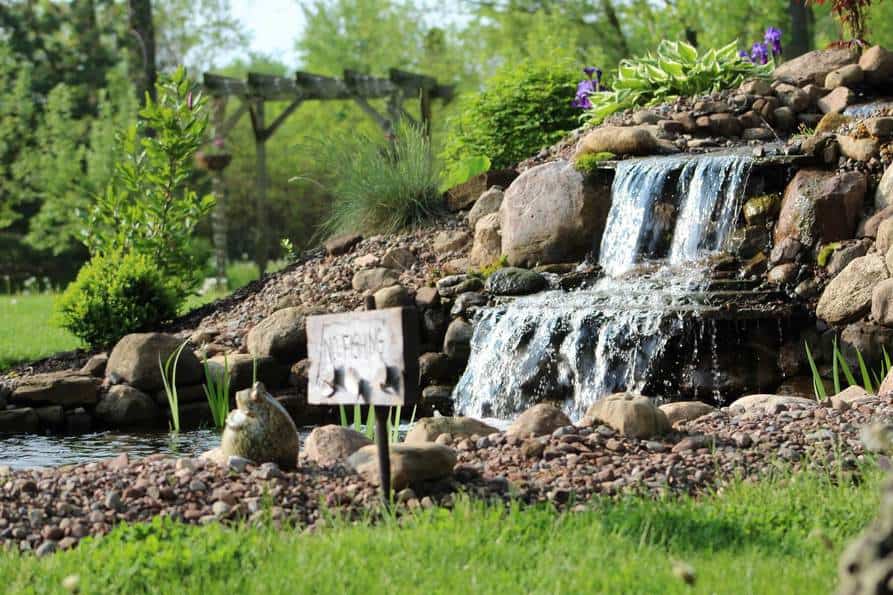
This guide will take you from an idea in your mind, walk you step by step and show you exactly how to build a pond. Create the outdoor space of your dreams.
Your new backyard water garden will be the envy of the neighborhood. Don’t get overwhelmed, take it one step at a time. Before you know it you’ll be enjoying a private waterfall right in your own backyard.
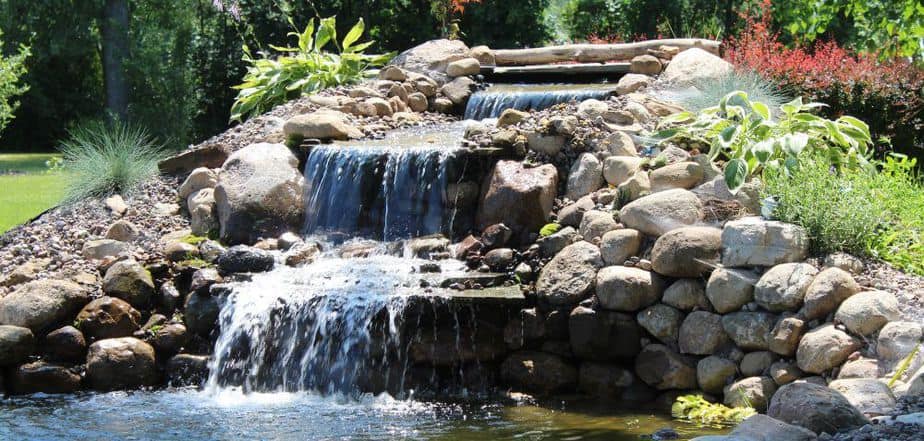
The best way build your pond is to break it down into easy to follow steps. Below are links for quick navigation to these steps. The steps are as follows:
There are many ways to approach your pond build. It all depends on the size and scope of what you want to do. If space is an issue then a typical waterfall pond setup may not be suitable. Check out our pondless waterfall (link to article) for ideas that don’t require quite as much real estate.
Don’t let your circumstances stop you. There is a water garden out there suited for every situation. You just need to find yours.
This guide will show you how to build a typical pond with a waterfall setup using a skimmer box and waterfall unit.
A pond kit is the most convenient way to be sure you have everything you need for your project.
***Note: Before you begin you will need a GFCI protected outlet. Most of the cords that are attached to the pond pumps are around 20 - 25 feet long.
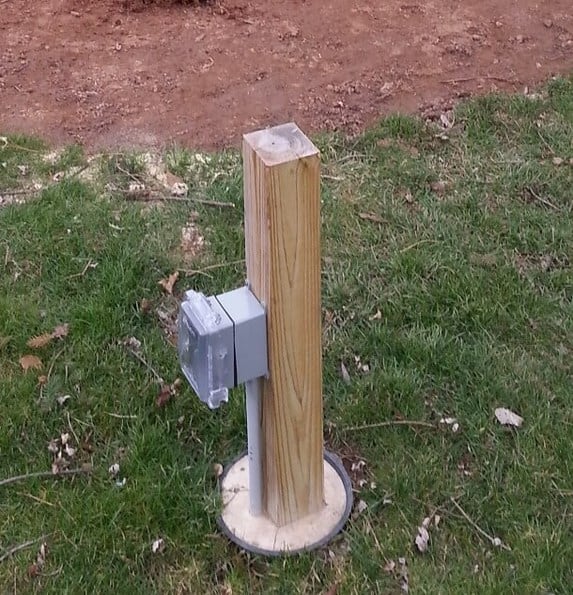
I did some prep work while I was still in the dreaming phase. When doing a previous project, I had an outlet installed nearby to power the future pond pump, lights or aerators.
The waterfall pump used in this guide came with a 25’. As long as there is power within that distance, you will be all set. Be sure the outlet is GFCI protected and you follow the electric codes for your area.
When you set out to bring your vision to life, change the dimensions to whatever suits you. What I used, fit my space and may differ from what you may be trying to accomplish.
Follow this exactly, or put your own spin on it, it’s up to you. Either way, something amazing will come out of it! This pond isn’t going to build itself, so let’s get started!
Pond Location & Layout
Do not take this step lightly. Take your time before you make your final decision. You will be happy you did.
WHERE to build Your Pond
Choosing a location so your new pond can be viewed in all four seasons is important to maximize your enjoyment. Your chosen location will allow you to enjoy it during the winter months as well as on a rainy day.
Take a ride to your local pond supply store, go on garden walks. Check Pinterest and other social media for ideas and inspiration.
Have fun and enjoy this stage, this is what it’s all about. When I did this my head was spinning with ideas. The possibilities are truly endless.
A view from your dining room, kitchen or living room is ideal. I’ve seen many people opt to put their ponds in their front yard. If that’s where it suits you best to have maximum viewing time throughout the year, so be it.
Pro tip - before you even get out your shovel, be sure there are no underground utilities on your site. Call before you dig. Visit http://call811.com/before-you-dig
Shape of your pond
Ok, you’ve chosen your location and are completely satisfied with it. Now it’s time to lay out the shape you envision. Location and layout go hand in hand.
Sometimes the location will dictate the shape of your pond. Other locations are a blank slate, like in my case.
Insert pond pics from customers here
Use something flexible like a garden hose or extension cord and let it take the shape you want your pond to be. Doing this will give you a good sense of what the finished project will look like.
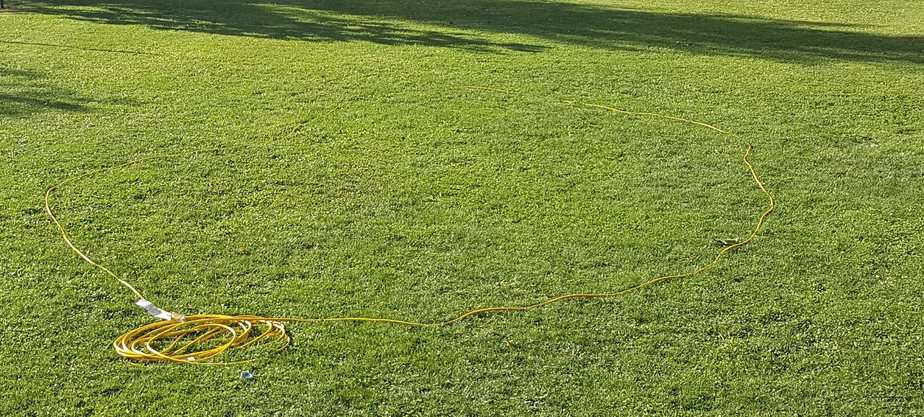
Take your time with this step. After you have done this, step back and look at it from various locations, inside and outside of your home.
I suggest you leave it for a day or so and see if it suits you. You want to be sure because changing location is difficult once you get started.
Sizing Your Pond
Don’t be afraid of going “too big” (as if there is such a thing). This is the one regret I have heard over and over again. A 10′ x 15′ foot pond may seem huge, but when you measure it out in your space outside it may not feel as large.
The best advice I’ve heard is to get the largest pond you can afford that fits in your space. Don’t throw in the towel just because you are short on space.
One more thing to consider during this layout phase is the placement of your water feature and skimmer box. These should be located at opposite ends of the pond to ensure proper water circulation.
Use a garbage can to represent your waterfall, giving you a visual as to what this will look like. Step back and see if it fits your vision.
When you are satisfied with the shape of your soon to be pond use a can of spray paint and spray just outside the perimeter you made with the garden hose or extension cord. Move the hose or cord out of the way as you go. This will give you an even clearer picture of what you are about to do.
Now, using a flat edged shovel chop around the entire perimeter.

This will create an edge for removing the grass if you have any. Scrape off all the grass about an inch deep. The sod you take out does not make good backfill, because it will settle quite a bit as the grass decomposes.
You have made most of the tough decisions, the size, shape and location are taken care of. Time to order all the supplies you will need.
Pond Supplies
Before you order your pond supplies there are a few decisions you will need to make. First is the depth of your pond. To get the proper size liner you must know the depth.
Depth also becomes important if you plan on keeping koi or goldfish in your pond. Even if you don’t think you want these amazing creatures in your pond, it is still a good idea to make it deep enough in case you change your mind.
This will determine how big of a pond liner you will need. When you get your pond liner you will also need underlayment to protect the liner from sharp sticks and rocks. Your pond liner and underlayment should be the same size.
Liner and underlayment
Your liner and underlayment are the only limiting factors to the size of your pond. Be sure your liner will be large enough. Use our pond calculator for determining the size liner and underlayment you will need.
This is the best time to order your supplies. Before you start digging so you can put your waterfall and skimmer box in place. It helps to have things where they will go as you build.
As you dig the pond, you will use the dirt to backfill around your waterfall unit. I’m not going to go into too much detail about supplies here, but here is a short list.
The Pond Kit
The best option is to use a pond kit (affiliate link to amazon for the best current price).
Find the right size kit for your project and take out a lot of the guesswork. All the components are sized right to work together in harmony when you use a pond kit. That’s what was used to build this project.
Most pond kits come with everything but the rocks, gravel, and flagstone. On a positive note, this allows you to use the materials that are native to your place in the world, and make your space look more natural.
Here is a list of the most common pond supplies you will need to get started. Kits come with most of this included:
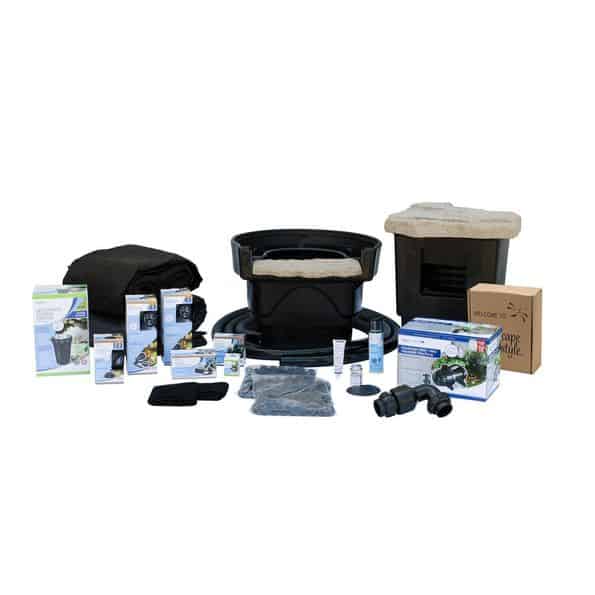
Digging Out Your Pond
Quick Story
Learn from my mistakes. I should have taken my own advice above. I did not call before I started digging. At about 12 inches down I ran into trouble. My shovel hit something.
Wouldn’t you know it, there was conduit (plastic tube that protects an electric line) running right through the middle of my pond location! I didn’t let this stop me. I had to dig around it, and then reroute it. It took some time, and it was a minor setback. Remember, “nothing worthwhile is easy”! Another of my “dad sayings”. OK enough with this tangent, now back to the task at hand.
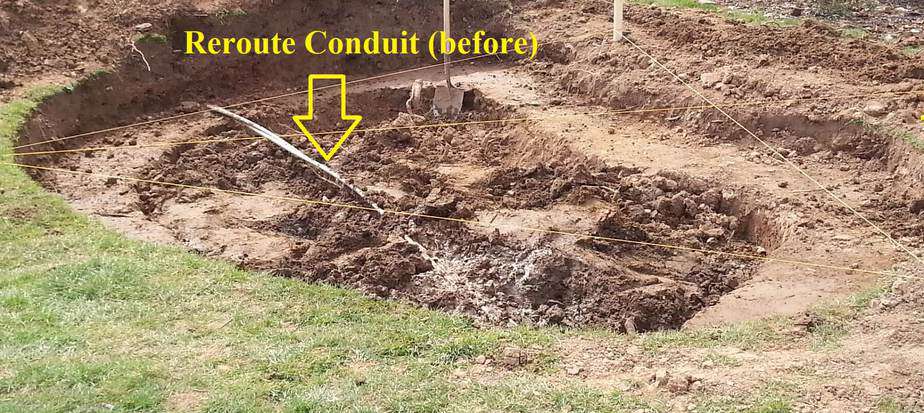
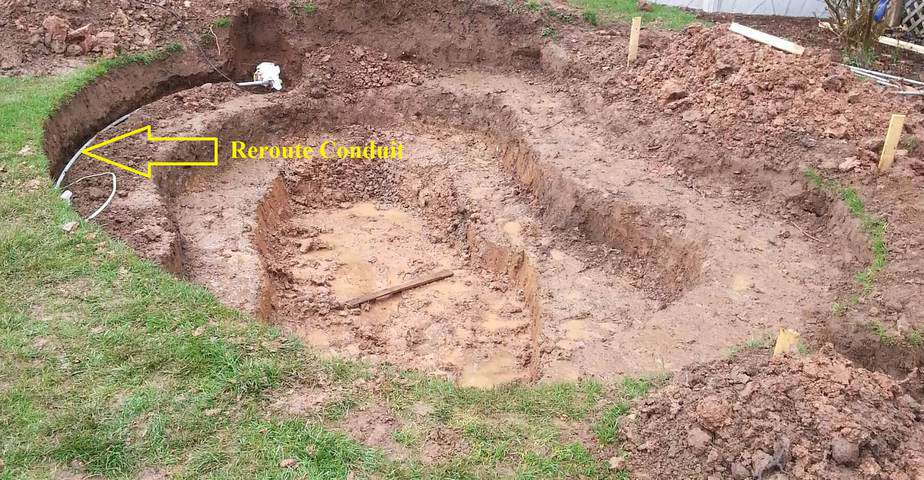
If you are renting equipment for the digging process you should wait for your pond supplies to arrive before getting started. This will allow you to place your waterfall unit and backfill around it as you dig out your pond.
If you are doing it the old fashioned way, with a shovel wheelbarrow... and iron will, get digging!
Digging your pond by hand is the best way to do it. This way you won’t be disturbing the ground below so there is less settling.
The pond in this example will have a 36-inch drop from where the waterfall spills out to the surface of the pond. In order to achieve that, the ground where the waterfall unit is placed needs to be raised.
Using 8-inch cinder blocks (standard size) directly under the waterfall unit gives it a sturdy base to rest on. Two courses of cinder blocks were needed below this waterfall unit to get the desired height.
How to minimize settling
Understand that settling will occur no matter what you do, but in order to keep that to a minimum. One key is to not disturb the ground beneath the blocks.
This minimizes settling. Fill the hollow cores of the blocks with dirt and compacted it down. Be sure the cinder blocks are level.

Now you have a sturdy, level surface to place your waterfall unit on that will settle very little.
Another advantage of using the cinder blocks is the fact you didn’t use dirt that’s excavated from the pond. This gives you more to work with for backfill around your waterfall unit.
Digging out your pond is simple… not easy, simple. You are going to dig down in steps creating different levels for pond plants to reside at different depths.
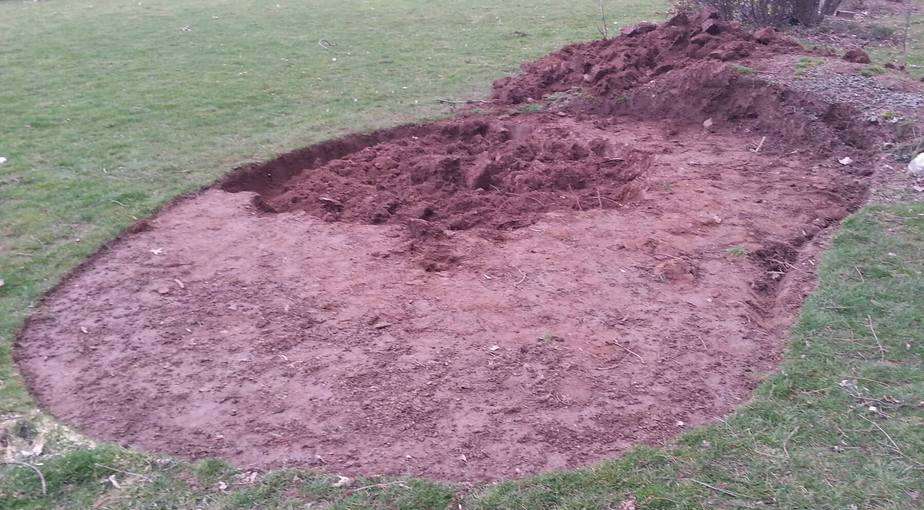
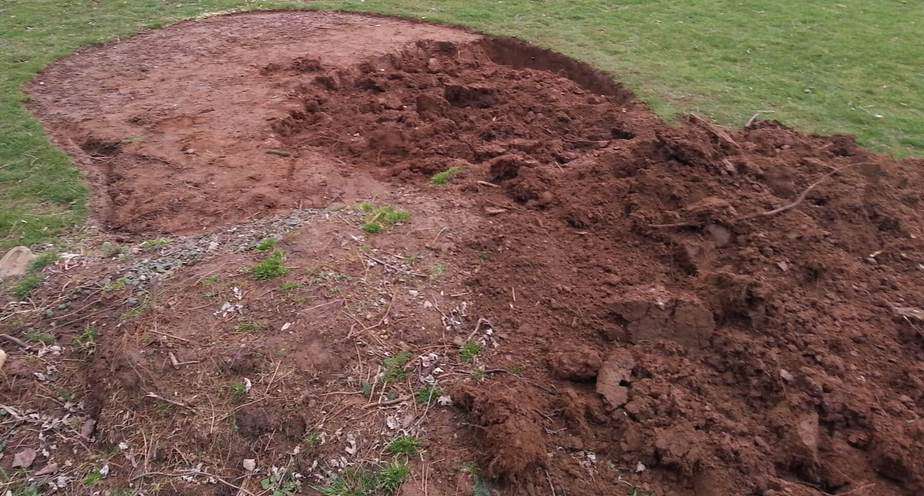

First dig the whole outline down about 12 inches deep. This creates the first “shelf” of your pond.
As you dig, dump the dirt around where your waterfall unit will go. Compact the dirt as you go using a hand tamper.
It’s amazing how much settling can occur in a season. Packing it down as you go will reduce settling.
Once you've dug down to a depth of 12 inches, you will need to carve out the place where your skimmer box will go. Just do a rough guess if you don’t have your supplies yet and dig down 12 deep here as well.
Now you will need to dig a trench from where your skimmer box is to your waterfall unit. The trench does not need to be below the frostline in your area for two reasons.
- Your pond is running, the water will be moving and will not freeze
- When you turn your waterfall off for the winter, the return line will be drained.
Dig the trench to a depth of about 12 inches.
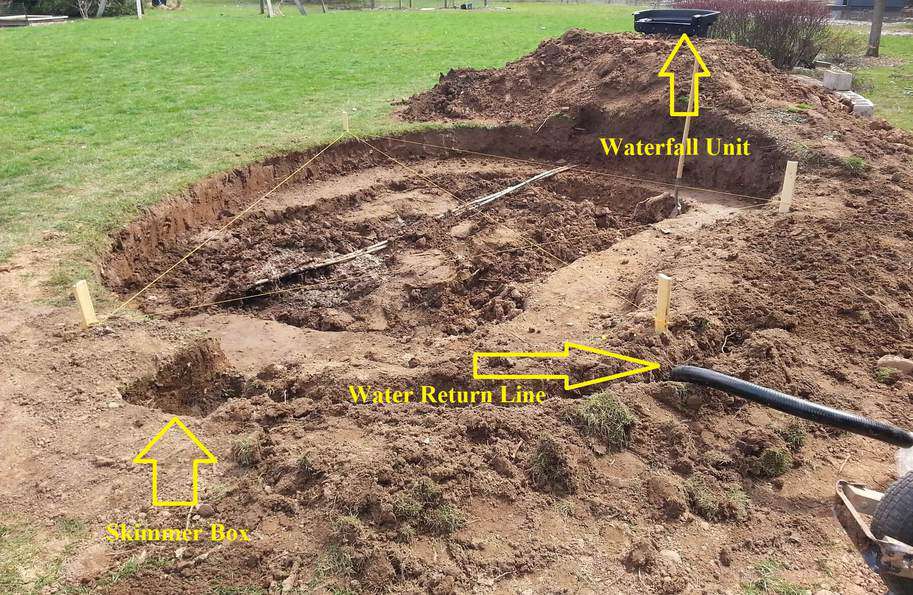
Pond Supplies
If you haven’t received your pond supplies yet you will need them before you go any further. I recommend waiting to place your waterfall unit before digging any more.
You want to be sure there is enough dirt to cover up, and gently slope your waterfall mound.
Once your supplies arrive follow the instructions and glue all the necessary fittings and to your waterfall unit. Attach your water return line to your waterfall unit and place it in its location.
Now lay your water line in the trench and make sure it’s long enough. In my case it was 4 feet short. A quick trip to the store fixed that. If needed you can add an extension using a rubber boot and pipe clamps.
Setting the waterfall unit
Before backfilling around it, check to see the waterfall unit is level from side to side. If it isn’t the water will rush out of one side and not the other.
To make the water flow properly make sure it is slightly pitched forward toward the waterfall opening. A line bubble on a level is sufficient.
Layer Your Pond
Now with the entire outer shape of your pond dug down to a 12-inch depth it’s time to grab your spray paint once again. This time create another shape, about 12 to 18 inches in from the edge.
You can either follow the existing shape of the pond, or create a different shape all together. This will make a 12 to 18-inch wide shelf for plants to thrive at various depths.
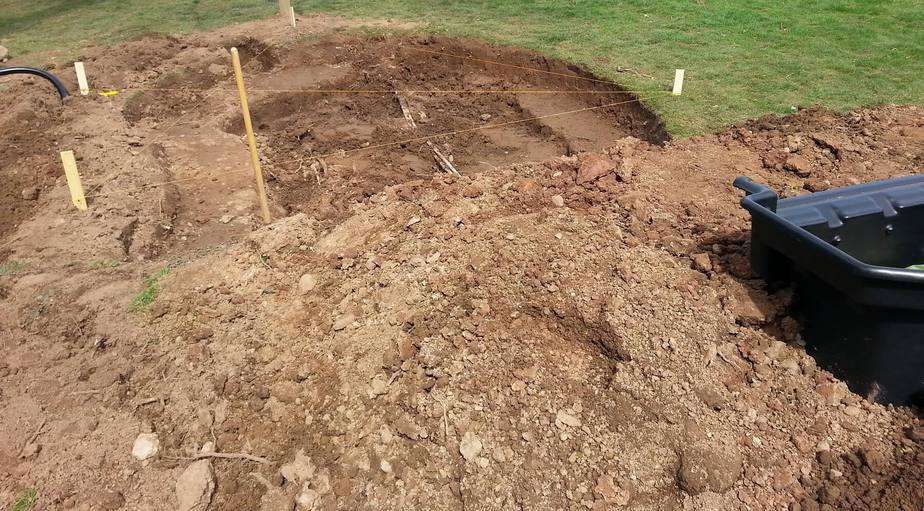
These “shelves” also help during the rocking process later, and when it’s time for seasonal maintenance. Not to mention helping you get in and out of your pond easier.
With your next shelf outlined, and your waterfall unit in place it’s time to start digging again. Dig this layer down another 12 inches, all the while placing the dirt around your waterfall, compacting it as you go.
Keep It Level
One key thing to keep in mind is that water always finds level. As you dig out your pond, make sure the ground around the pond is level. Use a long straight 2×4 or even an extension ladder with a level on top that spans the width and length of the pond to check for level.

In my case the ground had a slight pitch to it, so one side needed to be built up as I dug. This used up some of the dirt that was going to be used around the waterfall unit.
Note *** Your water level can never be higher than your lowest point.
UV Light In the Filtration System
Adding a pond UV light (link to installing a UV light in your pond) is optional.
Quick Story
When I initially put my pond in I regretfully opted not to add a UV light during the pond build. The very next season I was putting one in. I had to dig up the water line between the skimmer and waterfall unit and place the light in flow of my return line. Looking back, I would have just put one in right along with my pond installation.
If you need help choosing the right UV light for your pond (link to article) read our article.
Installing your UV light along with your pond installation is the easiest way. The best place to install your UV light is after the skimmer box. It should be installed in your return line back to your waterfall unit. The video below shows a typical UV light installation.
Pond Skimmer Box
Place your skimmer box on the ground where it will go and trace around it. Now dig out its shape. Your water line will be about a quarter of the way down from the top of your skimmer box opening. Keep this in mind when digging out for your skimmer box.
If it is too low, you will not be able to fill your pond as high as you may want to. Most skimmer boxes have a mark, or a bump on them to show you where the ideal water level should be. See the picture below of an installed skimmer box.

Do not dig deeper than you need to. Do your best not to disturb the ground below where the skimmer box will sit.
Your skimmer box must be placed level front to back and side to side. Don’t backfill around the skimmer box at this time in case you need to fine tune it later.
Final Pond Depth
Now for the last of the digging. Again, grab your spray paint and trace another outline for the final depth of your pond. Dig this shape out another 12 inches or so, again placing the dirt around your waterfall, and compacting as you go.
The pond in this example is now around 36 - 38 inches deep. If you have extreme winters, you may need to go down another level just to be sure your fish will survive.
As you go look for any sharp stones or roots where the liner will be placed. Doing this will help you avoid problems in the future.
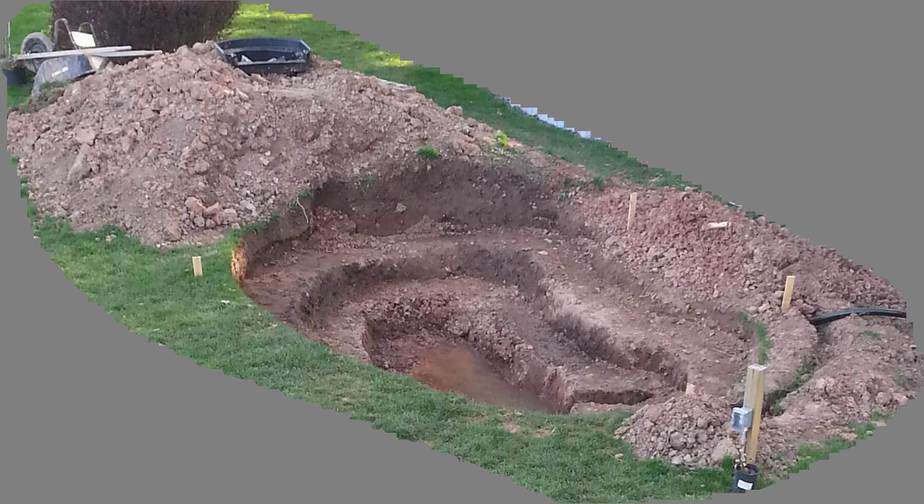
Keep in mind, these first few steps are some of the most important. Just like constructing a building, the planning and foundation are vital to the success of the project. The same holds true to building your backyard water garden.
Ok so now you have a giant hole in your space, it’s time to fill it back in. This is when the real fun begins. Step by step transforming your outdoor space bringing your water garden to life.
Hiding Place For Koi and Goldfish
All that’s left now is to give the inhabitants of your pond a proper hiding place. If you plan on having pond fish in your water garden, it’s a good idea to give them a place to hide from pond predators.
This can be accomplished by digging out a small channel. The liner will form to the shape you made. After the liner goes in, use a large drain pipe or bucket to be the walls of the “cave” then stack rocks around to hide it.
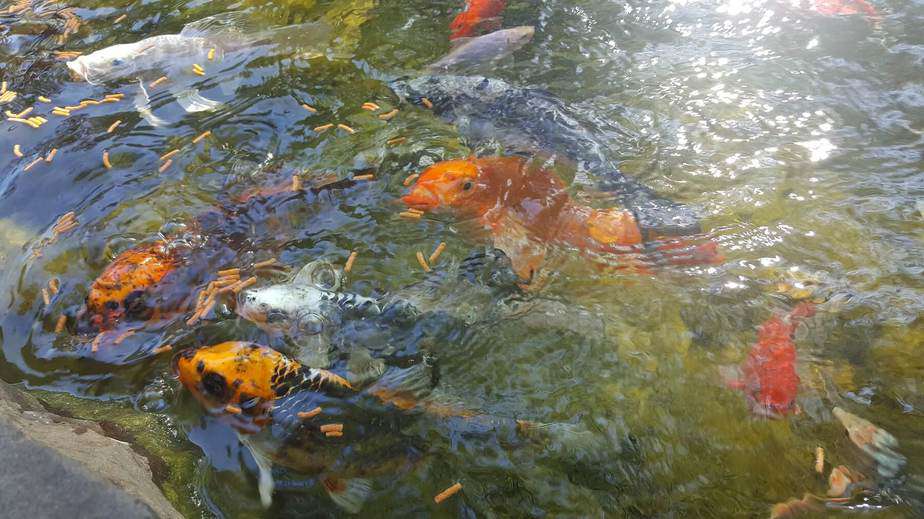
For this pond a 5 gallon bucket was used to form the cave initially.
Note *** A 5 gallon bucket works well for goldfish and small koi. However, as the koi grow larger, a bigger hiding place will be required. A piece of flagstone was placed over the second tier from side to side (see picture below) to provide shelter for all the fish in the pond

Once you start rocking in your pond the cave becomes more apparent.
Liner Underlayment
It will be helpful to have a second pair of hands for this next step. More than just a second pair of hands may be required if your pond is really large.
Unfold the underlayment all the way beside the pond. Lift the underlayment over the hole (be careful not to fall in) so it’s centered and let it fall into the hole. Be sure you have even amounts on all sides.
The underlayment should be big enough to have 12 inches of overhang on on all sides and over your waterfall and skimmer box (on opposite ends of the pond).
Once the underlayment is centered and placed in the hole, step in. Starting at the bottom kick it into place. Start in the middle of the bottom and work your way around the perimeter.
Remove any sticks, stones, or sharp objects you come across. Move up to the next level and do the same. When you finish the underlayment will have taken the shape of your pond.
Pond Liner Installation
This is definitely a two-person job depending on how big your water garden is. The pond liner is much heavier than the underlayment. When dealing with the liner, more care must be taken to ensure it is not damaged during installation.
Do the same with the liner as was done with the underlayment. Open it up all the way next to the pond. Gather your friends and lift the liner and center it over the pond. Once lowered in the hole, it needs to be formed to the shape of the pond.
Start in the middle of the bottom and work it so it lays as flat as possible and fully into the corners. I don’t recommend kicking it into the corner. On your hands and knees, push it where you want it to go.
The liner is durable enough to walk on, but it can be sliced easily. If you happen to slice your liner don't panic. Read our article on repairing a pond liner here.
When placed properly the liner should mimic the underlayment. Extending beyond the pond about 12 inches all the way around, including the skimmer box and waterfall.
Avoid the temptation to trim the excess liner. That will all be taken care of when you do all your finishing touches.
How to Rock in Your Pond
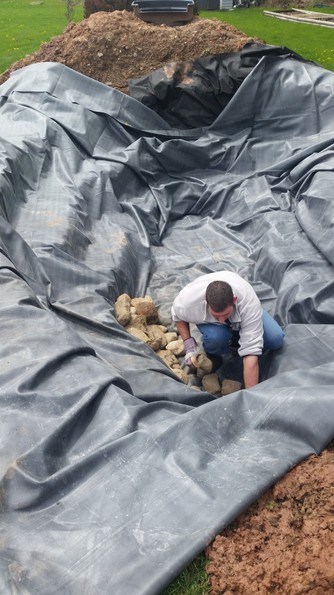
Let the fun begin! Time to start putting all the “pieces” together. This may look intimidating but just take it one step at a time and you will see exactly how to rock a pond. This is when all that hard work pays off. Your pond will come to life right before your eyes, one rock at a time!
With the liner in place begin placing rocks around the perimeter. Start at the bottom and work your way up. Dry stacking can be tricky, the rocks need to fit well together so they “lock” in place naturally. It’s a very tedious task, but when done right looks amazing!
Make sure the rocks are placed in the corner where the bottom meets the step. Never go higher than two rows where the seams line up without putting a rock across. You can see in the picture what I mean.
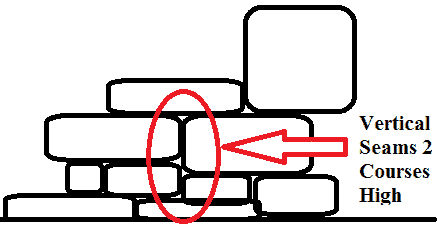
This helps add stability. Place larger rocks on the bottom row and build up from there. Be sure to set aside the best looking rocks for the very top of your pond, where the waterline will be.
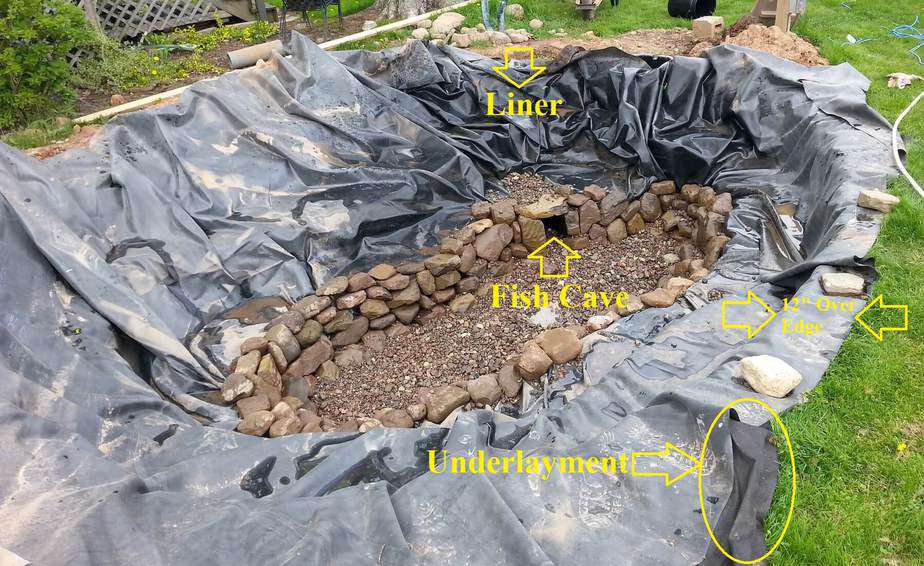
Once the first row of rocks has been built up, use gravel and cover the bottom liner with it. Use gravel as often as you see fit, filling small gaps behind and between rocks.
Do not concern yourself with the liner too much when laying rocks. The liner is tough and flexible. Rocks can be placed on the liner without worry. Avoid dragging the rocks across the liner, as it can be easily sliced.
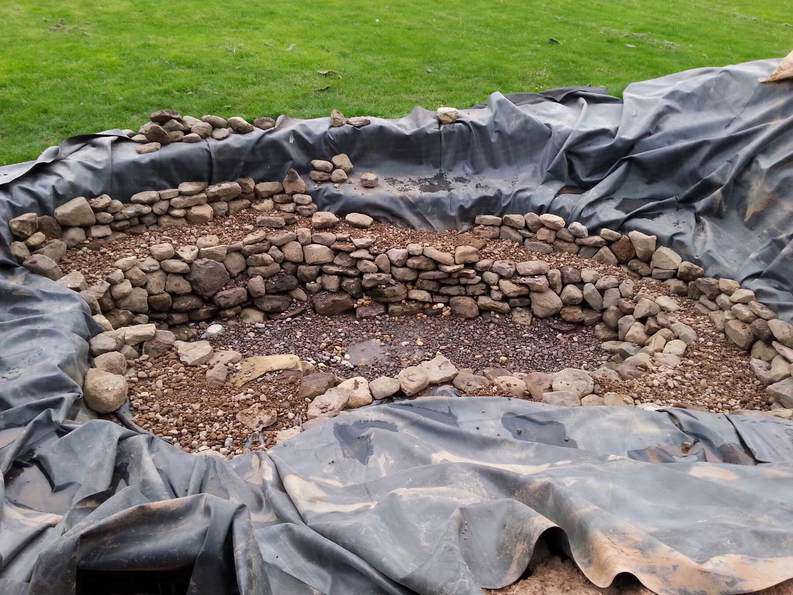
Another way to add stability to the rock structure is to use waterfall foam. It’s similar to spray foam insulation used to seal up cracks around the house.
The foam is a dark gray so it can be easily concealed. Use it sparingly, as it will expand as it cures. It should only be used as an added measure of stability and not to hold everything together.

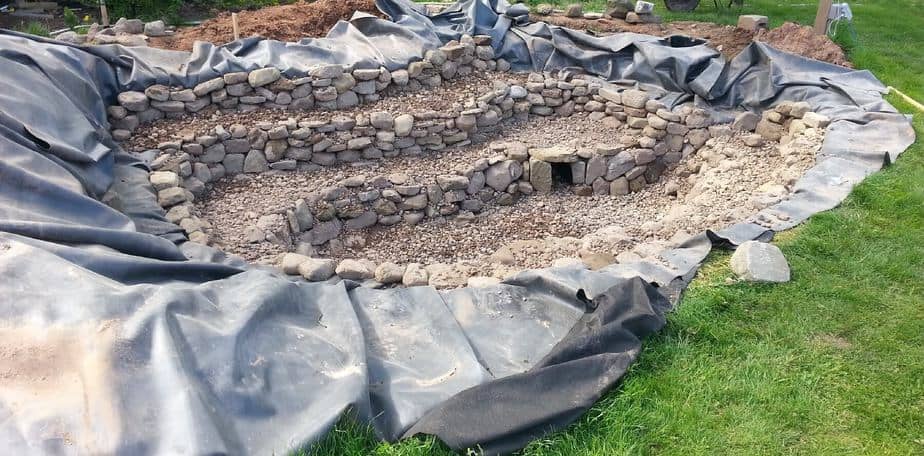
Fill all gaps with gravel first, this helps save on foam. Add a small amount of spray foam, then more gravel to hide the foam. Use gravel to fill in any large gaps as you go, again this adds to the stability of the entire structure.
Submersible Pond Lights
At this stage it's a good idea to add submersible lighting if that is in your plans. It's much easier to to hide all the wiring as you go. The kit I used only came with one submersible light. Looking back, I should have used a couple more, but that will be a project for another time.
Pro tip *** If your light has excess wire, wrap it around the light and then put it in place. This way when you go to change a bulb you can pull it up without having to dig up the wire you fished through the rocks.
Keeping a natural look
As you can see you will need a lot of rocks! The goal here is to essentially build a dry stacked stone wall. Save the biggest boulders for your waterfall itself.
Notice how in nature, a stream and waterfall are usually framed in by large rocks and boulders. If you try to mimic nature, you can’t go wrong.

Once you’re done with a layer fill the bottom up with about two inches of gravel. I used river rock that is native to the area for mine. There are all sorts of gravels you can use depending on the look you want.
Keep moving up, one layer at a time. Stop rocking when you reach your skimmer box.
How To Set The Skimmer Box
Be sure the hole you dug out for your skimmer box is flat on the bottom and the dirt is compacted below it. Once you put your skimmer box into place you don’t want it to settle or move.
Place your skimmer box in the hole and check that it’s level from side to side, and front to back. Remember, your water line will be approximately ¾ the way up from the bottom of the skimmer box opening.
Below is a picture of a skimmer box in use. The water level is low in the picture. You can see the bump on the side where the optimal water level should be.

Read the Manufacturer's Instructions
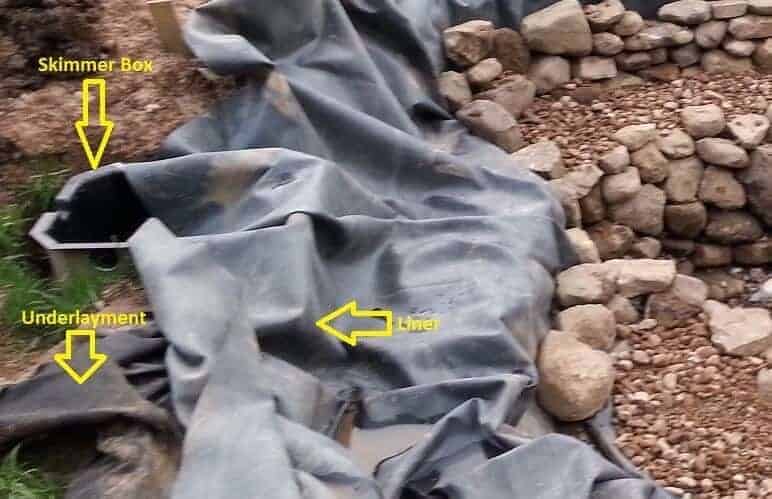
Before you begin it’s a good idea to read over the installation manual that came with your skimmer box, so you can familiarize yourself with it.
Push your liner into the corner where the skimmer box meets your first shelf. Allow for some slack there. You don’t want any tension on the liner around the skimmer box.
Now lay the liner vertically across the face of the box, so that it sits flat. Using a nail or other sharp object, poke a hole in the liner in the top right corner where the first mounting screw will go. Do the same for the other side all the while holding the liner steady.
Keep the nails there to hold your liner in place. From inside the skimmer box using a pen or marker, trace the opening. Fold the liner toward you and keep the nails in the liner. This will help to realign where you dry fit the liner.
Now place a ¼ to ½ inch bead of sealant about ¾ inch in from the opening you traced. Be sure the bead is continuous and there are no gaps.
Using the nails that are poked through the liner as guides place the liner against the skimmer box pressing firmly all around the opening. Rest the mounting plate on the nails.
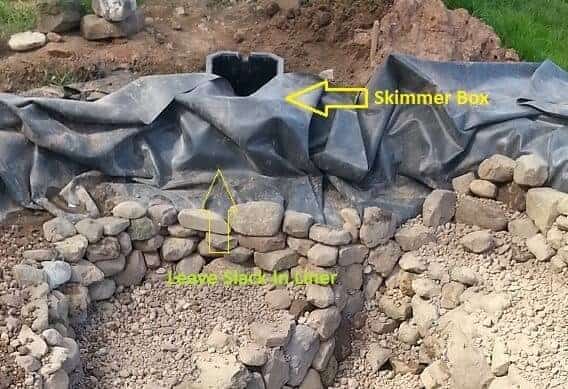
Remove the first nail and place in the first screw. Do the same for the other side.
Again using a nail make a puncture where the next screw will go, then install the screw. Do this repeatedly all the way around the mounting bracket until all the screws are in.
Pond Pump Installation
The skimmer box is in place, now is the time to attach your submersible pump to the waterfall return line.
Your pond equipment should be installed in the following progression:
Pump → check valve → return line → UV light (optional) → return line → waterfall unit. Be sure to install the check valve in the proper orientation. It is designed to only allow water to flow in one direction.
All the connections are made with rubber boots and hose clamps. Be sure the hose clamps are installed in such a way as to give you easy access to the screw.

The skimmer box is in place, now is the time to attach your submersible pump to the waterfall return line.
Your pond equipment should be installed in the following progression:
Pump → check valve → return line → UV light (optional) → return line → waterfall unit. Be sure to install the check valve in the proper orientation. It is designed to only allow water to flow in one direction.
All the connections are made with rubber boots and hose clamps. Be sure the hose clamps are installed in such a way as to give you easy access to the screw.
Pro tip *** Most of the pond kits come with standard hose clamps. It is a good idea to replace the standard clamps with stainless steel ones. The stainless steel will not corrode like the standard steel clamps do.
This will help during spring startup or any pond maintenance when you need to remove and service your pump in the future.
Building Up Your Pond
With your skimmer box set, finish rocking around the whole pond. Once you’ve completed a step, add gravel to the bottom and move on. When you get to the last course be sure to mix large and small rocks to make it look more natural.
At this point the rocks start to go up and over the bank of the pond.
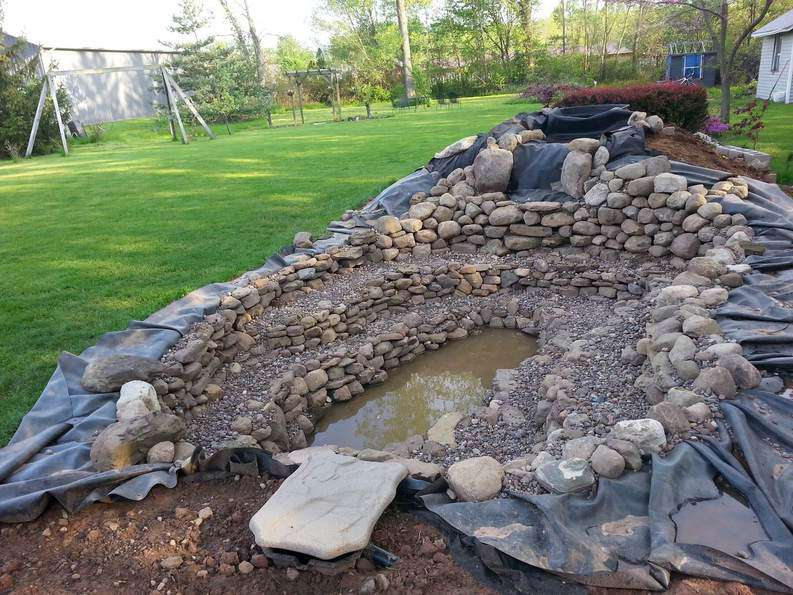
When you are stacking the rocks try not to rely on waterfall foam. Make the rocks ‘fit’ together and lock on their own. Use small rocks and stones between larger ones to lock everything into place.
If you are using waterfall foam be sure to disguise it with small rocks as you use it. Don’t over do it with the foam, and keep in mind that it does expand.
Building Your Waterfall
Your waterfall is the focal point of the entire project. For the sake of this guide we will just touch on this topic briefly. For a more in depth look into building a backyard waterfall (link to post). Check out our post.
As you build your waterfall, now is the easiest time to add any lighting you wish to add. Wires and the lights themselves may be more difficult to hide later.
I used a strip of waterproof led lights tucked under two of my spill over rocks. The light strips were secured with silicone to keep them waterproof.
The effect is really cool. Check out the picture below.


LED lighting like this allows the color to be changed via remote.
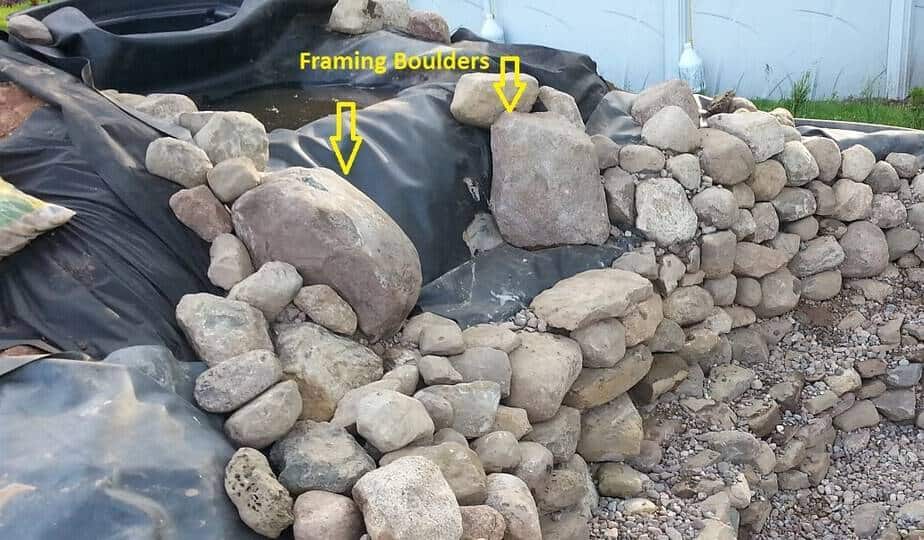
As you build up from where the water line will be, make sure you “frame in” your waterfall.
Mimic nature and you will have something spectacular! Use large boulders on the edge and flat slate for the spill over rocks.
How to Set Your Waterfall Spillway
Setting your spill over rocks can be tricky. You want the water to run over them properly so be sure they are set level across, and pitched slightly forward.
The biggest issue when building your waterfall is for the water to go where you want it to. Many times most of the water winds up running behind your spillover rocks rather than over them. This can be fixed with the use of some waterfall foam.This is where the waterfall foam comes into play again.
You won’t know for sure how the water will flow until you actually turn your waterfall on. If you foam between your spill over rocks and the liner, the water should flow over the rock instead of behind it.

Hide all the foam with gravel before it cures completely. Stop rocking when you get close to the waterfall unit.
Attaching Your Waterfall Unit
There may be specifics that aren’t mentioned here, so be sure to read the manual that came with your waterfall unit. Just like previously when we attached the liner to our skimmer box, we are going to follow the same process. The key points are the same.
Key Takeaways
Finishing Your Waterfall
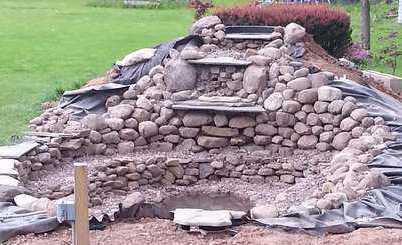
Allow your sealant to cure before building around your waterfall unit. Once cured, build up your rock framework.
Continue rocking up to the waterfall unit, again using larger rocks as a border.
Make sure the liner is under the bordering rocks and higher than the water line will be. Backfill behind the liner with dirt or other rocks to hold it in place.
Again, avoid the temptation to trim the liner at this point. It will be done with all the finishing touches later after everything is up and running.
Rinse and repeat
Once you’ve covered everything with rocks, it’s a good idea to wait at least 24 hours to let all the sealant, and waterfall foam cure. I know all you want to do is fill it up. The anticipation is killing you!

Everything needs to be washed down at this point. I purchased a cheap, dirty water pump (link to the pump on Amazon) from amazon to accomplish this. If you’ve encountered rain during any of this, the pump is handy for that as well.
Spray down all the rocks with a garden hose, pumping the dirty water out of the bottom. It’s amazing how much dirt is actually on the rocks and gravel. Keep doing this until the water is fairly clear. Don’t get crazy, you will never get it all.
Pond Filter Media
The kit used in this project came with all the necessary filter media. For an extra layer of filtration it’s a good idea to add lava rock to your waterfall unit.
The lava rock will be home to some of the beneficial bacteria that will keep your water looking great all season long. Beneficial bacteria break down waste and keep your water quality high.
Rinse the bag of lava rock to remove all the dirt and dust. Now place it in a mesh bag on the top of your waterfall unit. The lava rock can be easily concealed with a piece of flagstone. See picture below.
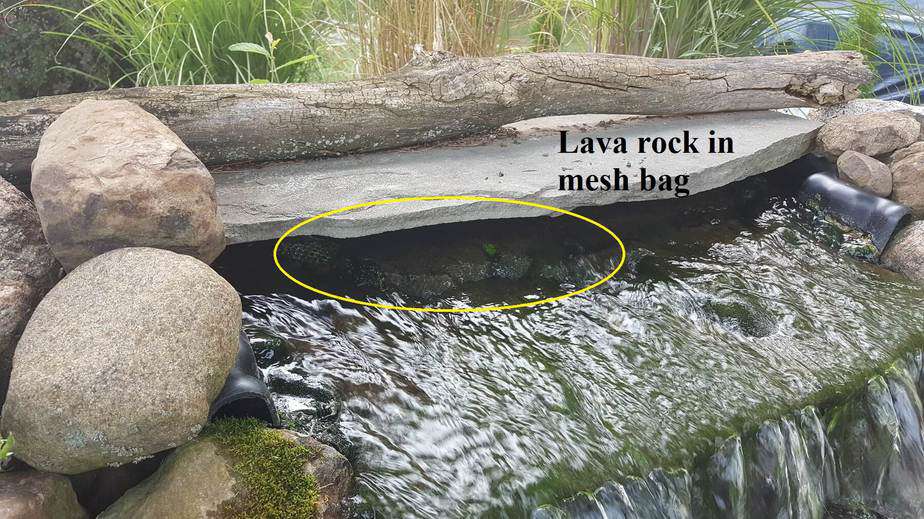
There are other ways to filter your pond besides the one in this guide. If you want to build a bog filter (link to our guide) for your pond, or just want to know what one is check out the article.
Fill Your Pond

Time for the moment of truth. Start filling your pond. This may take some time, depending on the size of your masterpiece! At this point it’s a good idea to test your lighting systems and make sure everything is working properly. At least that’s what I told myself… I am a bit impatient and I couldn’t wait for nightfall.
In all reality, this is a perfect time to sit back, grab a drink, and relax a bit… you deserve it. All that digging and stone work takes its toll.
Once the water level is where it should be, about ¼ of the way down from the top of your skimmer box opening its time to test the system.
Avoid the temptation of turning on your submersible pump too early. If it runs dry you will do damage to the pump, so be patient.
Make sure you have an audience, and a drum roll is a must! Turn on your pump and watch your backyard come to life as your pond adds a new dimension to your outdoor space.
Let your pump run for at least 24 hours and keep an eye on your water level. If it goes down you may have an issue somewhere that will need to be resolved before you go any further.
If your water level goes down don’t panic. The most common reason for this is water is splashing out, or getting around the liner somehow. This can usually be resolved with waterfall foam and redirecting the water flow to stay within the liner.
Finish Building Your Pond
Here is what's left to do, the necessary steps that need to be taken to finish the project. After that the rest is up to you. Let’s get started.
pond edge treatments
At this point you’ve filled your pond and are running your waterfall, but the entire thing is bordered by wrinkled rubber liner. Take the excess liner and wedge it between two rocks, so that it is sticking up between them, then trim the excess.
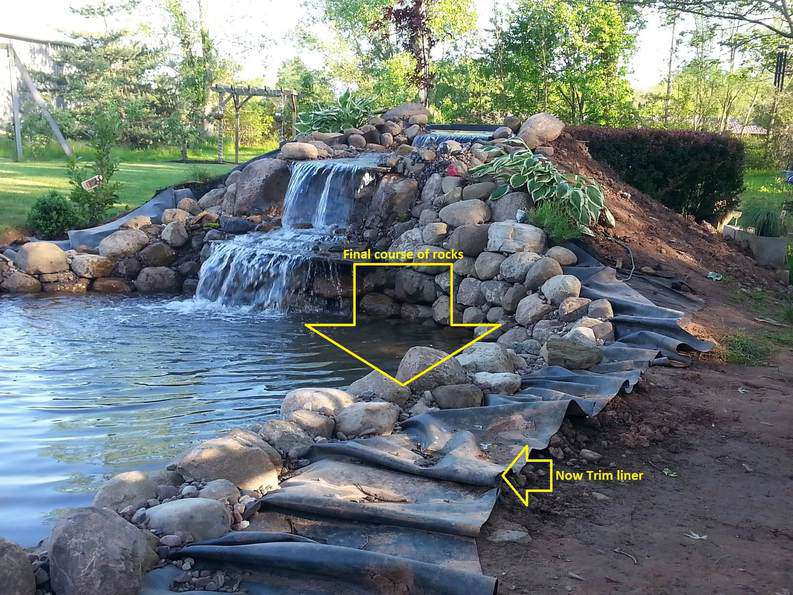
I know it sounds like common sense, but be sure the liner is higher than your water line, or you will have issues. This may be tough to see at some points, especially where the water flows down your waterfall.
I used river rock on one side of the garden, and on the other side flagstone was added. The flagstone provides an inviting path for viewing and feeding the fish.
If river rock, or any kind of small rocks are going to be used around the edge, be sure to place landscape fabric under it. That will stop the small rocks from sinking into the ground. The fabric is also a great weed barrier. Weeds can be easily removed if fabric is used.
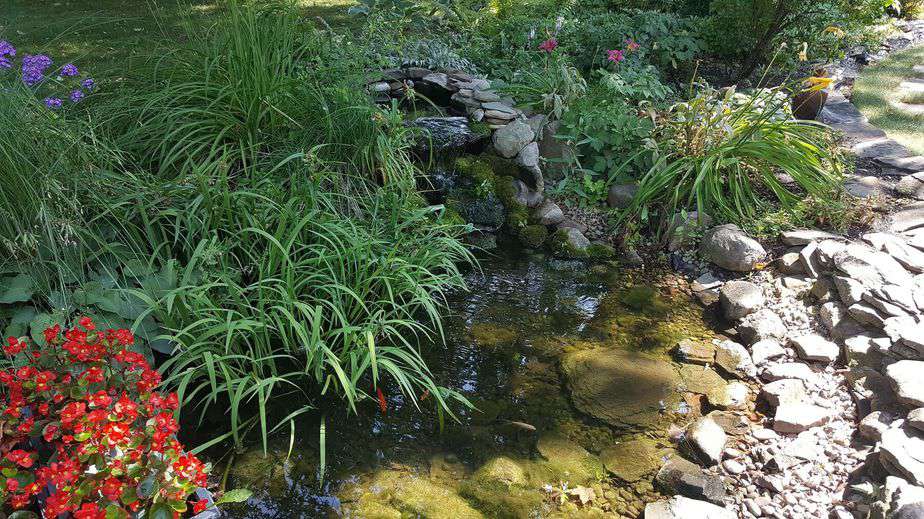
Stone and rocks are not the only thing to use as edge treatments. Mulch is another viable option depending on the look you want. Use plants around the perimeter to soften the transition. Choose the best transition from pond to land to make the whole landscape blend together.
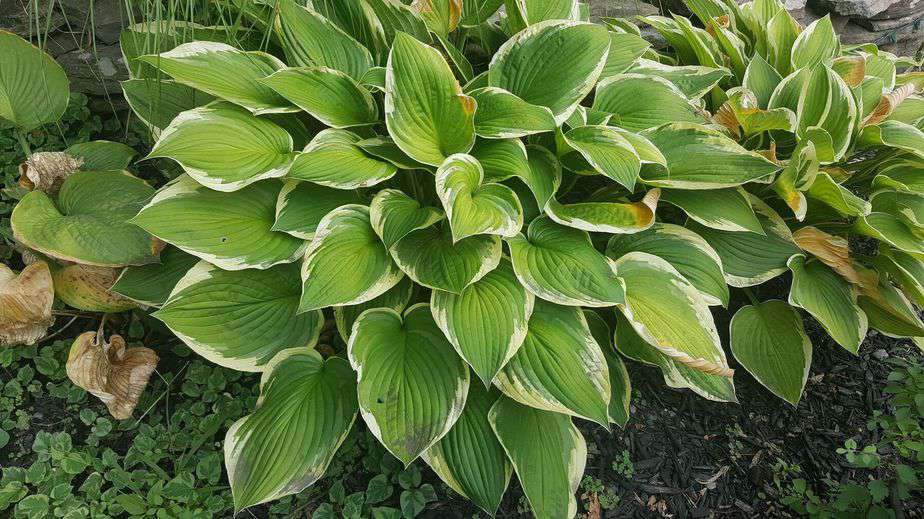
Clear Pond Water
It’s important that there are enough plants planted in your pond. They will use up excess nutrients from fish or other decaying matter. If your water is rich with nutrients, not only will your plants thrive but so will unwanted algae.
Having a well planted pond combats this and keeps balance in your pond ecosystem. For a more in depth look at keeping balance in your pond check out our guide to muck control (link to article).
Be patient, when you first build your pond it may take a season or two for the plants to “take root” and mature. That goes for plants in and out of the water.
Pond Plants
Using plants around your pond helps to soften the edge. Making a natural transition into the surrounding landscape.
The types of pond plants used will depend on what zone you live in. Use the hardiness zone map that the USDA publishes to determine if a plant is suitable for your area.
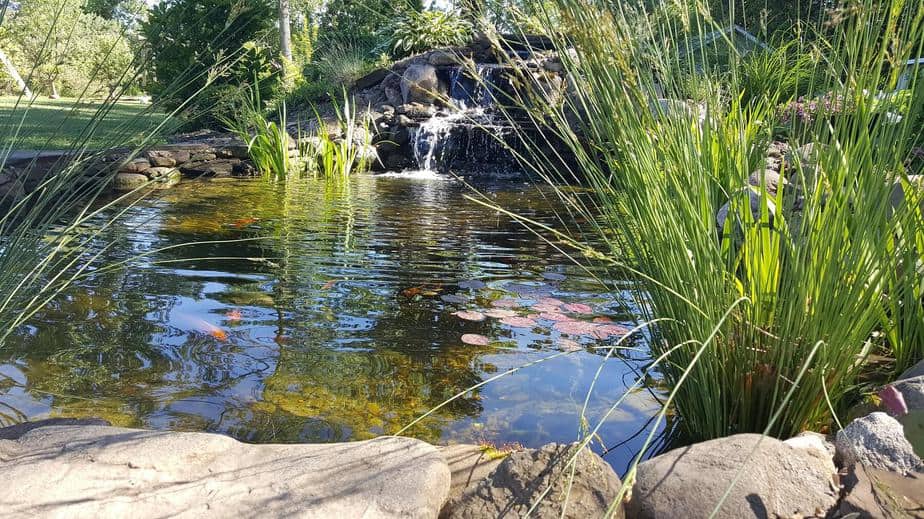
Not only do plants help keep the water clear, they are a great way to hide the pond liner around the perimeter. Tuck your plantings right behind the liner to help hold it up.
Plants in the water provide oxygen for fish and reduce the spread of algae, acting as a natural water filter.
Water plants like water lilies not only provide shade, but also protection from predators. Giving your fish cover is essential for their survival, especially when they are small.
If adding lilies to your pond, get the hardy variety (you can get them right on amazon with this link) they are easy to care for and can survive great swings in temperature.
Not all aquatic plants are suitable for use in a pond with a liner. Beware, pond plants like cattails are not recommended to use in a pond with a liner. Cattails have been known to grow their roots right through it, causing leaks.
Conclusion
We’ve come to the end of our journey and now you have a blueprint of how to build a pond. If you would like to download a printable version of this guide to take with you to the job site or look through at your leisure you can download it here. Following this guide will get you professional results!
Please leave a comment below because I answer every single one. I want to help you get the outdoor space you have been dreaming of.
Building Out the Ultimate Backyard
Now that you have an amazing backyard water garden pond, complete with a waterfall don’t stop there. Add more elements and create an inviting outdoor space that will be the envy of the neighborhood.
Adding a patio of some kind within view of your new water feature. A place for family and friends to gather, sit and relax. No outdoor space would be complete without a place to cook up some tasty food. Perhaps adding a grill island and bar with a concrete countertop would help round out the whole ‘at home get away’ experience.
~Jeff



This pond turned out beautifully! I love how you layered the pond with the rocks and the pond liner. What brand of liner did you end up using? I've been doing research on different liners, and it seems like there are a lot to choose from. Thank you for sharing!
Brittany,
In my opinion there is only one kind of liner to use, and that’s an EPDM rubber liner. Be sure to get one that is 45mil thick. These liners are versatile and durable. They will not break down when exposed to sunlight.
Most come with a 20 year warranty. The life of your liner will be much longer when installed properly. Be sure you use geotextile underlayment beneath the liner. This helps to protect it from roots or any other shifting that may occur underneath it.
These rubber liners will flex and stretch, the only downfall is they can be sliced fairly easily. Keep that in mind when you are building your pond. They are hard to puncture, but if you drag rocks across it you run the risk of slicing it.
Dear Jeff: I have just finished reading your article on How to Build the Ultimate Pond. It was amazing! Extremely well written and clear! My "pond" is still at the dream stage and the physical exertion is probably beyond my own abilities at the moment. But I am enjoying this part of the process and I am certain that when I am able to move on to the more concrete stages your articles will be my primary, if not my only, resource for this project.
Thank you again. Andrea
Thank you Andrea, it’s always nice to hear positive feedback from someone that found value in what I am doing. Good luck with your project, and I would love to see pictures of the finished project when you get there!
Jeff,
I have been looking up information on ponds and building one for the last year. This is sad but true. I started to think I was digging my grave sight instead of a pond after a while;-) Anyway, I wanted to share that the information you have here and the way you laid it out is the best I’ve come across so far. I’m very grateful, thank you…I’m actually going to finish my pond now!!!
Brian
Brian,
I know exactly what that feels like. There are moments when I want to quit during my projects as well. If you keep pushing through, you make it to the finish line… somehow.
Just keep thinking how great it will be when you are relaxing beside your amazing waterscape! Best of luck to you. Thank you for the positive words, and I’m glad I could help.
Cheers,
~Jeff
Its beautiful how big is it?
Thanks, it is approximately 11 feet wide and 17 feet long, with its deepest point being 36inches.
Great article. Very detailed. Best one I have read so far. Thank you!
Thank you for the positive feedback, it is greatly appreciated!
Cheers,
Jeff
I just read this entire amazing post although I’m only trying to make a tiny pond for my tortoise in the UK. Thank you so much for all the information, I’m very jealous of your pond!!!
I beleave you have the best step by step instructions. I've read. How do I get a hard copy. Thank you for being so clear Donna. PS I'm digging my pound now hope to get it done with you instructions. We'll send results.
Thank you for the kind words. I’m glad you found the article helpful. I look forward to seeing your results. If you would like to download a digital copy of my book you can at https://backyardwatergarden.com/ultimate-guide/ I wish you the best of luck with your project.
Cheers,
~Jeff
Great tutorial now I'm ready to get it done. Thanks very much
Thanks, good luck on your project!
Jeff–your instructions about the pond building were very thorough and clear. I can see you had a lot of insight into the construction. I'm just getting started on my project. I know it will take time so I won't rush into this adventure. I also look forward to some of you other descriptive pamphlets.
Thank you for the kind words. Yes take your time and plan everything out before you begin. Just understand that things rarely go according to plan. I would love to see pictures of your finished project when you get there. Best of luck to you.
Cheers,
~Jeff
After I read this, I called up a contractor of ponds and pond kits near me here in Colorado to start on my Koi pond project! I was so inspired by this great article that I instantly wanted to have a pond! Now I'm really enjoying it and it's just beautiful! Thanks to you guys!
Thats great! Nothing better than doing a project after you find inspiration. Enjoy your backyard water garden!
Hi Jeff,
I really love this tutorial and want to use it as a guide for my future pond. Thanks a lot for making this. I have a question though: How much stone did you use for this pond and what stone sizes? I need to buy it per cubic meter and don't want to order to much. Thanks in advance
Glad you are enjoying it. I am not quite sure how much stone I used. I got it down the road from a farmer and loaded it into my truck. I would guess around 10 pallets. A pallet is about 1 cubic meter I would assume. I also used 4 tons of small gravel (river rock). Don’t worry you can never have too much when it comes to stone. Good luck with your project. I would love to see pictures when it is finished!
Cheers,
~Jeff
If I paid for your book, how can I access it?
An email has been sent to you with a link to your purchase.
Thank you.
Hi there, what a brilliant step by step guide to sorting out a garden pond, read it several times and now printed it off. I hoped to use limestone rocks and boulders to line the pond but a couple of people have suggested this might alter the pH of the water to the detriment of the fish. Where I live there are many stately homes which I presume have limestone as there main feature and the fish/wildlife seem to thrive. Clearly I need to be absolutely sure it is safe to use the limestone and wonders if you could offer any guidance please. Many thanks in anticipation
Stuart,
Limestone will change the pH of your water. It should not however go above what is tolerable for pond fish. The good news is that goldfish and koi prefer a higher ph anywhere from 7.0 to 8.6. If you are concerned about this simply get a test kit similar to the ones used for swimming pools and test your pH before adding any fish.
Also, Be sure not to overstock your pond (this is very easy to do… believe me) as this will add more ammonia to the water and create a toxic environment. I’m glad the guide helped. I would love to see pictures of your finished pond. Good luck!
Thanks for sharing. Your pond is beautiful! I have one question. Did you put in any kind of mechanical filter, or are the lava rocks and the skimmer, with the ultraviolet light you added in the second year, the only "mechanical" filtration (as opposed to plants)?
You are correct, I did not add any other mechanical filtration system. It is a skimmer, lava rocks, and UV light.
I do also use the aquascape dosing system. Here is a link to the video I made about it https://youtu.be/QL6beB9nvvc . The dosing system is a game changer. All together my pond stays clear with very little effort.
Jeff, i inherited a small pond (7' x 9') rectangle, no shelves, slant bottom down to about 15" depth. I want to enlarge it just slightly and make it deeper to overwinter fish safely. As I look at your plans. i am wanting to add a bog to improve water quality, but also very much want the waterfall feature. Can i do both with only 1 pump? should i run the pump to the waterfall and let it fall into the bog portion of the pond, with no piping under the gravel? will the bog actually help in this type of set up?
Yes you can run the entire system on one pump. Be sure your pump is robust enough to get the flow rate you want for your waterfall. You can divert water to a bog by using PVC pipe and a T. Control the flow rate with a valve. Good luck to you!